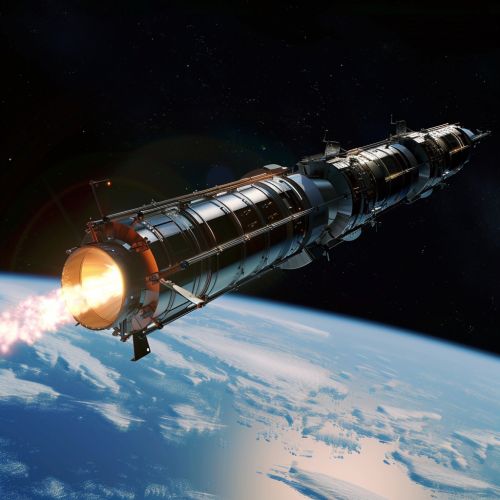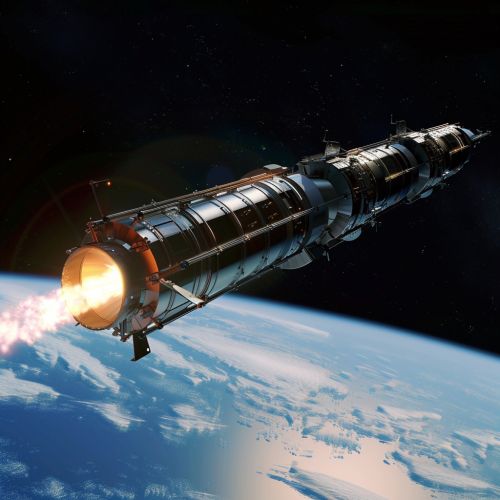David Budens Nuclear Rocket Propulsion (1980): Difference between revisions
(Created page with "== Introduction == David Budens' Nuclear Rocket Propulsion (1980) represents a significant milestone in the field of advanced propulsion systems, particularly in the context of space exploration. This article delves into the comprehensive details of Budens' work, exploring the technical aspects, historical context, and implications of his contributions to nuclear rocket propulsion. == Historical Context == The development of nuclear rocket propulsion can be traced back...") |
No edit summary |
||
| Line 47: | Line 47: | ||
* [[Cryogenic Storage]] | * [[Cryogenic Storage]] | ||
[[Image:Detail-97251.jpg|thumb|center|A nuclear rocket propulsion system in space, with a visible reactor core and exhaust nozzle.|class=only_on_mobile]] | |||
[[Image:Detail-97252.jpg|thumb|center|A nuclear rocket propulsion system in space, with a visible reactor core and exhaust nozzle.|class=only_on_desktop]] | |||
== References == | == References == | ||
Latest revision as of 08:31, 27 July 2024
Introduction
David Budens' Nuclear Rocket Propulsion (1980) represents a significant milestone in the field of advanced propulsion systems, particularly in the context of space exploration. This article delves into the comprehensive details of Budens' work, exploring the technical aspects, historical context, and implications of his contributions to nuclear rocket propulsion.
Historical Context
The development of nuclear rocket propulsion can be traced back to the early 20th century, with significant advancements occurring during the Cold War era. The Nuclear Thermal Rocket (NTR) program, initiated by the United States in the 1950s, laid the groundwork for subsequent research. By the 1980s, the focus had shifted towards more efficient and powerful propulsion systems, with David Budens emerging as a pivotal figure in this domain.
Technical Overview
Principles of Nuclear Rocket Propulsion
Nuclear rocket propulsion operates on the principle of using a nuclear reactor to heat a propellant, typically hydrogen, which is then expelled through a nozzle to produce thrust. This method offers a higher specific impulse compared to chemical rockets, making it ideal for long-duration space missions.
Reactor Design
Budens' design incorporated a compact nuclear reactor, utilizing highly enriched uranium as fuel. The reactor core was designed to achieve high temperatures, facilitating efficient heat transfer to the propellant. The use of moderator materials, such as graphite, helped in maintaining a controlled nuclear reaction.
Propellant Handling
The choice of hydrogen as a propellant was driven by its low molecular weight, which translates to higher exhaust velocities and, consequently, greater thrust. Budens' system included advanced cryogenic storage solutions to maintain hydrogen in its liquid state, ensuring efficient handling and minimal losses.
Thermal Management
Thermal management is critical in nuclear rocket propulsion to prevent overheating and ensure the longevity of the reactor components. Budens' design featured innovative cooling techniques, including regenerative cooling, where the propellant was circulated around the reactor core before being expelled, thus absorbing excess heat.
Performance Metrics
Specific Impulse
Specific impulse (Isp) is a key performance metric in rocket propulsion, representing the efficiency of the engine. Budens' nuclear rocket achieved an Isp of approximately 900 seconds, significantly higher than the 450 seconds typical of chemical rockets.
Thrust-to-Weight Ratio
The thrust-to-weight ratio is another crucial parameter, indicating the engine's ability to produce thrust relative to its weight. Budens' design achieved a thrust-to-weight ratio of 10:1, making it suitable for a variety of space missions, including interplanetary travel.
Applications
Deep Space Exploration
One of the primary applications of Budens' nuclear rocket propulsion system was deep space exploration. The high specific impulse and efficient propellant usage made it ideal for missions to Mars and beyond, reducing travel time and increasing payload capacity.
Orbital Maneuvering
In addition to deep space missions, Budens' propulsion system was also considered for orbital maneuvering tasks. Its ability to provide sustained thrust over long durations made it suitable for adjusting satellite orbits and conducting rendezvous operations.
Challenges and Limitations
Radiation Shielding
A significant challenge in nuclear rocket propulsion is the need for effective radiation shielding to protect both the spacecraft and its occupants. Budens' design incorporated advanced shielding materials, such as borated polyethylene and tungsten, to mitigate radiation exposure.
Regulatory and Safety Concerns
The use of nuclear technology in space propulsion raises several regulatory and safety concerns. Budens' work addressed these issues by adhering to stringent safety protocols and conducting extensive testing to ensure the reliability and safety of the propulsion system.
Legacy and Impact
David Budens' contributions to nuclear rocket propulsion have had a lasting impact on the field of space exploration. His work paved the way for subsequent advancements in propulsion technology, influencing both governmental and private space endeavors. The principles and designs he developed continue to inform current research and development efforts in nuclear propulsion.
See Also


